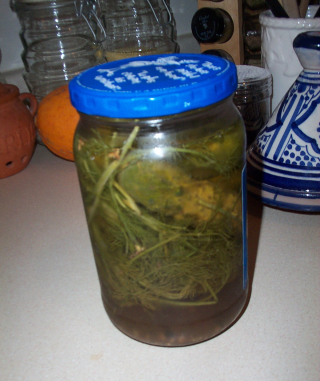Fun with grenades
Grenadine: Sirop fait du jus de grenade ou imitant le sirop de grenade
(Source: Petit Robert)
Sometimes, relationships that are clear in one language are obscure in another. For example, I never used to know what grenadine was made of. The ingredient lists on most commercial grenadines offer no insight, since they contain no fundamental differences from, say, the ingredient list on a bottle of soda.
In French, however, the connection is clear: the root of grenadine is grenade, which, in English, is a pomegranate. Hence greandine's red colour, which experience suggests is its only distinguishing feature. The definition of grenadine given above also underscores another point, however. It defines grenadine as a "syrup made from pomegranate juice or imitating pomegranate syrup." And imitating is the key word here, since, again, most commercial grenadines have never even been in the same room as a pomegranate.
As my husband will tell you (probably while sighing and rolling his eyes), I've been on a cocktail kick recently. One standard ingredient I make for cocktails is simple syrup. At its most basic (I'm tempted to say, at its "simplest"), simple syrup is just equal parts of sugar and water, mixed (and often heated) to dissolve the sugar. The resulting syrup is then used to sweeten cocktails without leaving a film of grit in the bottom of your glass. When I made my most recent batch, I wanted to store it in a capped squeeze bottle in the fridge. The only such item available in the local hardware store was a pair of bottles, one yellow, one red, intended to be used for mustard and ketchup. "Hmm," I thought to myself as I poured the simple syrup into the yellow bottle, "What can I put in the red one?"
Then one day, it hit me. I could make my own grenadine -- real grenadine, made from pomegranates! At its most basic, grenadine is just simple syrup, with pomegranate juice in place of the water. There are a number of variations: many recipes suggest adding some vodka or neutral spirits as a preservative, and some recipes suggest reducing the pomegranate juice by half before mixing the sugar in. I followed the most complicated approach, reducing the juice by half, heating to dissolve the sugar, and adding a tablespoon of vodka as a preservative.
You can find pomegranate juice at most major grocery stores these days, thanks to the rising popularity of pomegranates as a source of antioxidants. So there's really no excuse for using commercial grenadine. Just make sure the juice you buy is 100% real pomegranate juice; otherwise, you may as well just use the commercial kind, since it has a longer shelf life. (There are also a number of real-pomegranate commercial grenadines on the market. Fee Brothers' American Beauty grenadine is one. I've ordered a bottle of it, and am curious to see how it will stack up.)
There are lots of cocktails that call for the red syrup; The Internet Cocktail Database lists 538 of them. One that's recently gotten my attention (and is currently sitting on my desk) is the El Floridita. It's sort of like a fancy Daiquiri, but with a hint of chocolate and a nice red colour. You can learn more about it at The Spirit World blog.
El Floridita
1 1/2 ounces white rum
1/2 ounce lime juice
1/2 ounce sweet vermouth
1/2 teaspoon white crème de cacao
1/2 teaspoon grenadine
Place all ingredients in a cocktail shaker filled with cracked ice. Shake hard. Strain into a chilled martini glass.
Cheers!

